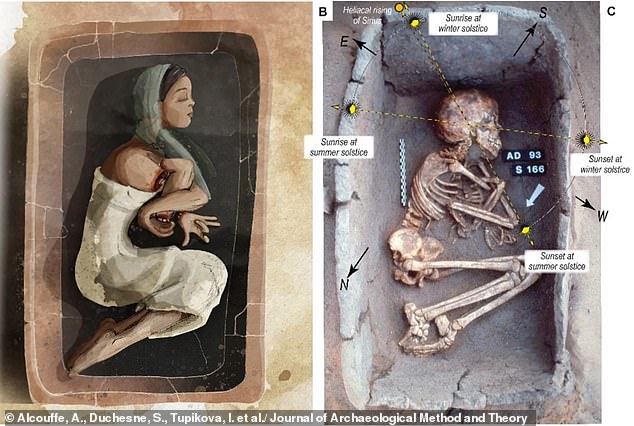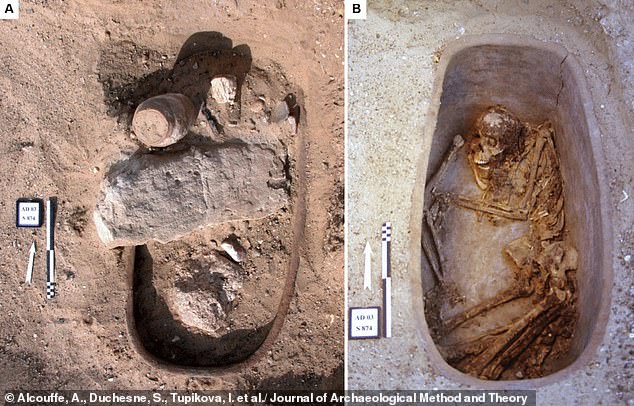Archaeologists have uncovered disturbing burial practices of ancient Egyptians, offering rare insight into the spiritual life of villagers more than 5,000 years ago.
Among the most striking discoveries was the body of a teenage girl buried in the Adaiima cemetery near the Nile River, dating back to 3300 to 2700BC.
Her arm had been deliberately severed post-mortem near the lower part of the upper arm and forearm, possibly done using an axe, and the muscles were likely sliced with a flint blade.
Those who prepared her body carefully arranged the severed pieces to appear almost intact, placing the hand beside the forearm.
Archaeologists said that it seemed the goal was to make the cut-off right arm match the unusual position of her left arm, which was bent sharply, more than a right angle, and tucked in very tightly.
The girl’s body was also carefully aligned with the setting sun on the winter solstice, and her coffin pointed toward the rising of Sirius, the brightest star in the sky.
Experts suggest her burial may be the earliest sign of the Osiris and Isis myth, in which the goddess Isis reassembles the dismembered body of Osiris beneath the rising Sirius, symbolizing death, rebirth, and cosmic order.
According to the study, these early star-based alignments and symbolic gestures likely influenced the religious traditions later embraced by Egypt’s first pharaohs, who emerged roughly 100 to 400 years later.

Archaeologists found remains of a teenage girl buried over 5,000 years ago. Those who buried her first cut off her arm and laid it over her chest

The team found other burials throughout the ancient cemetery, with remains placed in certain alignments of stars
Researchers used AI and machine learning to analyze patterns among more than 900 tombs in the 74-acre Adaïma site, one of Egypt’s oldest and most thoroughly studied cemeteries.
Their findings revealed long-term cultural shifts in funerary customs, including the gradual emergence of social hierarchies and spiritual symbolism.
Another woman was found buried nearby with ornate jewelry and pottery, her coffin positioned to capture the winter sun.
A third grave held a woman with a ceremonial staff and plant-fiber wig, facing the summer sunset.
These early sky-based alignments and ritual gestures appear to have shaped the mythology later adopted by Egypt’s ruling elite, according to the study.
Later graves were often clustered around earlier, astronomically-aligned tombs, suggesting those burials held enduring religious or ancestral significance.
Some included ivory boat models and fine coffins, likely marking individuals of higher status or spiritual importance.

Experts suggest the young girl’s burial may be the earliest hint of the Osiris and Isis myth
One child’s bone was found placed on an adult’s chest, while a woman was buried with a bracelet fragment in her hand, actions interpreted as deliberate expressions of spiritual beliefs and afterlife connections.
In the myth of Osiris, Isis gathers the scattered body parts of her murdered husband after he is slain by his jealous brother, Set.
Using magic, she brings him back to life briefly to conceive their son Horus. The tale, symbolizing resurrection, was closely tied to the annual Nile flood and cycles of renewal.
According to another study on ancient Egyptian astronomy, ‘The Nile flood was caused by the tears that Isis shed, after his brother Seth murdered her husband Osiris.’
‘Sepdet, which we know as Sirius, was believed to be the appearance of Isis in the sky,’ the study stated.
These early rural burial practices, including cut limbs and celestial alignment, appear to have laid the foundation for Egypt’s later religious and mythological traditions.
‘When the state emerged, it did not create religion from scratch,’ the researchers wrote.
‘It absorbed long-standing practices and reworked them into royal narratives.’









